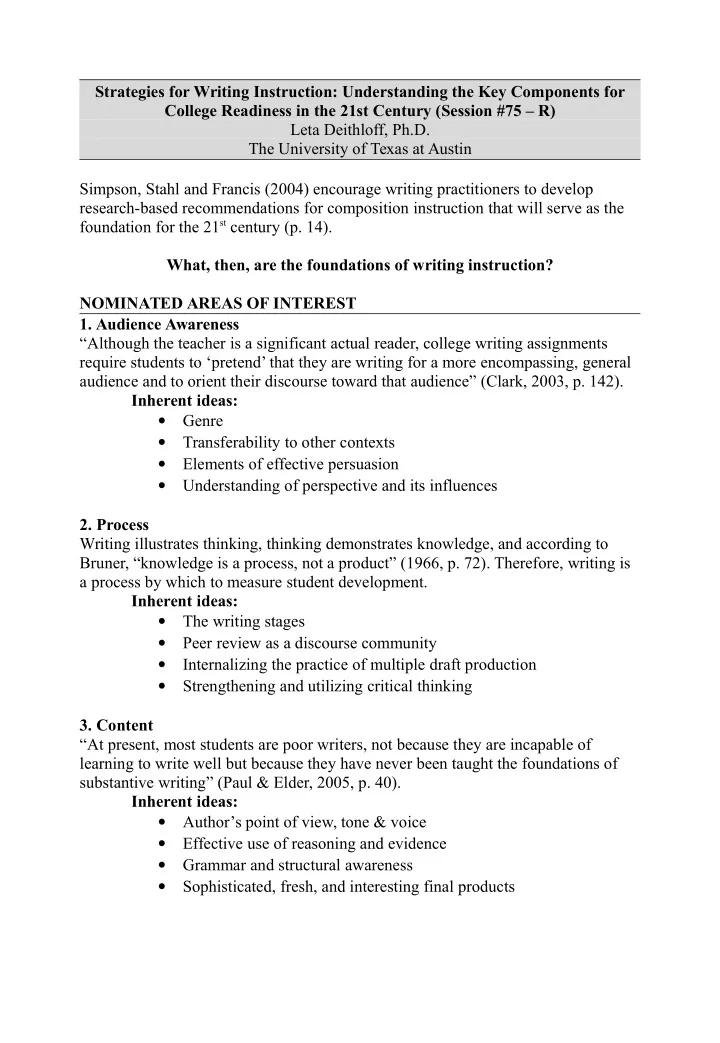

Strategies for Writing Instruction: Understanding the Key Components for College Readiness in the 21st Century (Session #75 – R) Leta Deithloff, Ph.D. The University of Texas at Austin Simpson, Stahl and Francis (2004) encourage writing practitioners to develop research-based recommendations for composition instruction that will serve as the foundation for the 21 st century (p. 14). What, then, are the foundations of writing instruction? NOMINATED AREAS OF INTEREST 1. Audience Awareness “Although the teacher is a significant actual reader, college writing assignments require students to ‘pretend’ that they are writing for a more encompassing, general audience and to orient their discourse toward that audience” (Clark, 2003, p. 142). Inherent ideas: Genre • Transferability to other contexts • Elements of effective persuasion • Understanding of perspective and its influences • 2. Process Writing illustrates thinking, thinking demonstrates knowledge, and according to Bruner, “knowledge is a process, not a product” (1966, p. 72). Therefore, writing is a process by which to measure student development. Inherent ideas: The writing stages • Peer review as a discourse community • Internalizing the practice of multiple draft production • Strengthening and utilizing critical thinking • 3. Content “At present, most students are poor writers, not because they are incapable of learning to write well but because they have never been taught the foundations of substantive writing” (Paul & Elder, 2005, p. 40). Inherent ideas: Author’s point of view, tone & voice • Effective use of reasoning and evidence • Grammar and structural awareness • Sophisticated, fresh, and interesting final products •
4. Strategy Recognition “The ultimate goal is for students to evaluate their performance in terms of their strategic actions or lack thereof” (Simpson, Stahl, & Francis, 2004, p. 3). Inherent ideas: Metacognition and subsequent strategy development • Affect and its influences • Motivation and its influences • Reflection as a tool for metacongition (metawriting) • 5. Assessment “Assessment has become a complex and often political topic that has been debated at every level from the individual classroom to school boards and state legislators” (Neff Lippman, 2003, p. 200). Inherent ideas: Scaffolding, mentoring, & modeling • Modes of assessment, including electronic writing spaces • Pre-writing activities: feedback opportunities + grading time-savers • Authentic assignments for greater learning generalization • Implications and Implementation Notes: References Bruner, J. (1966). Toward a theory of instruction . Cambridge, MA: The Belknap Press of Harvard University Press. Clark, I. L. (2003). Audience. In Concepts in Composition: Theory and Practice in the Teaching of Writing (pp. 141-160). Mahwah, NJ: Lawrence Erlbaum Associates, Inc. Neff Lippman, J. (2003). Assessing Writing. In Concepts in Compostion: Theory and Practice in the Teaching of Writing (pp. 199-220). Mahwah, NJ: Lawrence Erlbaum Associates, Inc. Paul, R., & Elder, L. (2005, Fall). Critical Thinking...and the Art of Substantive Writing, Part I. Journal of Developmental Education, 29 (1), 40-41. Simpson, M. L., Stahl, N. A., & Francis, M. A. (2004, Winter). Reading and Learning Strategies: Recommendations for the 21st Century. Journal of Developmental Education, 28 (2), 2-4, 6, 8, 10-12, 14-15, 32.
For further information or questions, contact: Leta Deithloff, Department of Undergraduate Studies, The University of Texas at Austin, 512-301-6682, ldeithloff@austin.rr.com
Recommend
More recommend